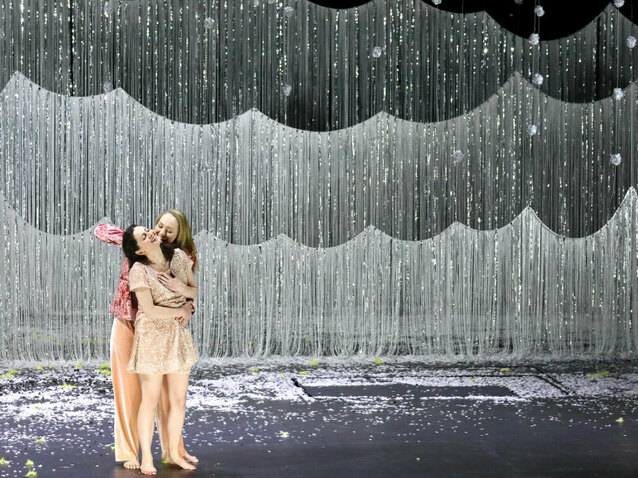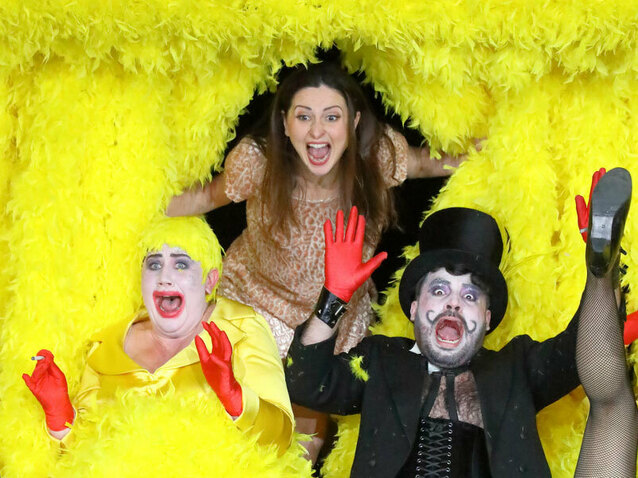 © Gran Teatre del Liceu
© Gran Teatre del Liceu
The use of a narrative, discursive or argumentative strategy based upon making animals speak is almost as ancient as culture itself. From Aesop to Disney, passing through La Fontaine and Orwell, the device of granting human language to animals has been employed in various ways and for various purposes, yet almost always with an educational aim - education meant in its broadest sense. In one way or another, we are all children of Disney. How many childhood tears, crucial to our emotional education, must have been shed through Bambi?
The presence of chattering animals in opera is rather scarce; tenors and sopranos have always been reluctant to dress up as roosters and hens. Nevertheless, there are some examples, with Příhody lišky bystroušky (The Cunning Little Vixen) standing out as the main one. This opera, which opens the current season at Liceu, was composed between 1921 and 1923 by Leoš Janáček, based on his own libretto inspired by comic strips published in newspapers. It premiered in Brno in 1924 and didn’t reach Liceu until 2001, in an English version of the original Czech.
Janáček tackled composing the piece when he was nearing seventy, at the height of his wisdom as a composer, when he had finally achieved fame and recognition, and when he was also beginning to sense the approach of death.
In The Cunning Little Vixen, Janáček does not fall into the easy trap of presenting an idyllic nature in contrast to a destructive humanity. In the forest where the vixen lives, there is both celebration and death, pleasure and pain, but there is neither malice nor hatred. Outside the forest, humans drown their repressed desires in alcohol, yearning with sadness and to no avail for lost youth. The final morality, the educational intent of The Cunning Little Vixen, revolves around accepting the cyclical nature of life, which necessarily requires the existence of death in order to be and to complete itself.
It is highly significant that Janáček chose the final scene from this opera as the music for his own funeral, where the forest keeper, old and weary, marvels at the beauty of the forest bathed in the golden light of the evening.

The Cunning Little Vixen, Gran Teatre del Liceu (2025)
The opera was staged by Australian director Barrie Kosky in a co-production between Liceu and the Bayerische Staatsoper, which premiered in Munich three years ago. While it is not Kosky’s best work, he does not betray the piece nor distort it, yet neither does he resolve it in a convincing manner. The set design, which replaces the traditional forest with bright curtains illuminated in a striking manner, ends up being repetitive and lacking in meaning. The production dispenses with the traditional masks, hairstyles, and elaborate makeup typically seen in productions of this opera and establishes a simple yet effective code: humans are dressed in black, and animals in colour.
Musically, soprano Elena Tsallagova stood out, with her beautiful tone and solid projection, shining in the central role of the Vixen, infusing it with vivacity, transparency, and mischievous charm. Tsallagova, who had already performed in the premiere of this production in Munich, commands the role with ease and comfort. Her antagonist, the forest keeper, was played by Swedish baritone Peter Mattei, making his debut in the role. Mattei was confident and performed well, though despite the central register of the role being comfortable, he did show signs of fatigue during the long solo scene, which constitutes his major contribution.
Paula Murrihy was highly satisfying in the role of the Fox, and in general, all the singers gave convincing performances. Special mention goes to the excellent performance by the Orfeó Català Children’s Choir, which plays a surprisingly important role in this opera, featuring unusually significant parts for children’s voices.
The musical direction was entrusted to Josep Pons, an expert on the composer and the period. The sound of The Cunning Little Vixen is peculiar and distinct from any other operatic orchestral sound. The score exists in a magical, almost impossible place, where the broader Slavic romantic tradition, particularly the Czech one Janáček was trained in, intersects with the influence of Czech folk music, the refinement of French impressionism, and the harmonic audacity emerging from the Germanic world in those years. The result is a wonderful, incredibly difficult-to-perform music - delicate, yet unusually strong and of an extraordinary personality. Orchestrally, The Cunning Little Vixen is a masterpiece.
Pons sought this unique sound, but only partially achieved it on the opening night. The ensemble sound was not refined enough, and the orchestra seemed unpractised and out of shape after the long summer break. It is likely that this will improve in future performances. The dynamic balance between the large orchestra required by the piece and the singers, who at times struggled to break through the orchestral wall of sound, will also need further attention.
Xavier Pujol
Barcelona, 22th September 2025
The Cunning Little Vixen (Příhody lišky bystroušky) by Leoš Janáček. Elena Tsallagova, Paula Murrihy, Peter Mattei, David Alegret, Sara Bañeras, Mercedes Gancedo, Alejandro López, Anaïs Masllorens, José Manuel Montero, Roger Padullés, Milan Perišic, Mireia Pintó. Orchestra and Choir of Gran Teatre del Liceu. Conductor, Josep Pons. Stage director, Barrie Kosky. Restaging, Andreas Weirich. Scenography, Michael Levine. Costumes, Victoria Behr. Lighting, Franck Evin. Coproduction by Gran Teatre del Liceu and Bayerische Staatsoper. Gran Teatre del Liceu.
the 24 of September, 2025 | Print
Comments